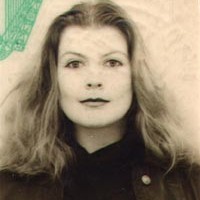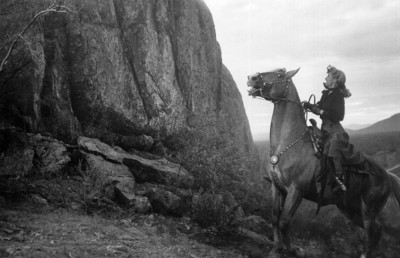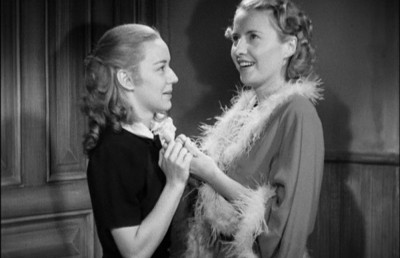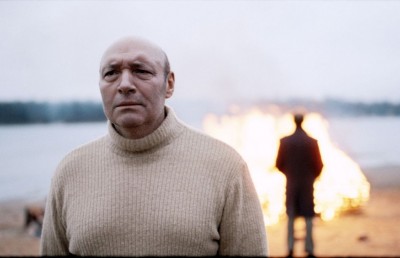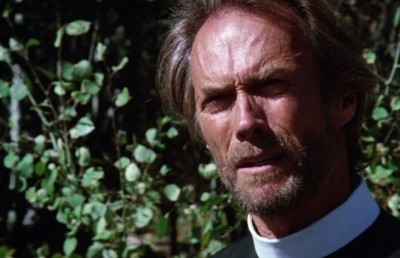Steers, Queers and Pioneers: Barbara Stanwyck’s 1950s Westerns: Part 2: Post-The Furies
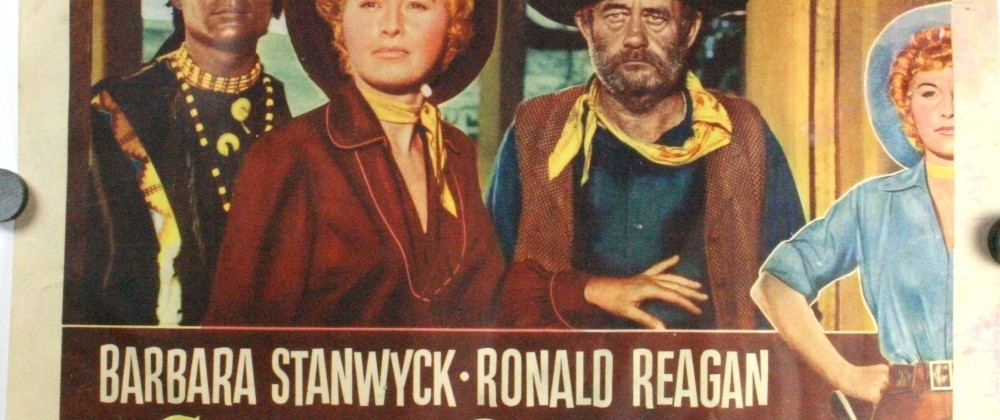
Released 16 August 1950, The Furies was probably the first great psychological western in that fabled generative cycle but was not a box office success. It was the part of Mann’s great trilogy of westerns that year – he also directed The Devil’s Doorway and Winchester ’73 in a burst of activity that saw him leave B movies behind and establish an A-list reputation based on a serious approach founded on a rigorous aesthetic developed from working alongside such great lighting cinematographers as John Alton, whose work with him on The Black Book (1949) was some of the most astonishing of the era. Now he sought to make robustly psychological works and commenced a string of great western works and The Furies extols what Geoff Andrew calls his “classical interest in the evils of patriarchy” (Andrew, 1989: 190). As Lucas avers, “the heroine figures strongly in every Mann western and tends to have a decisive influence on how the narratives play out … for all his acknowledged brilliance with space and landscape, revenge motifs and climactic gunfights, Mann would not deserve his place as a key figure and defining force in the genre’s classical maturity if the women were as weakly drawn as some have alleged … it’s hard to think of a director who has given us a more fetching and varied group of women … within one decade’s worth of westerns” (Lucas in Kitses and Rickman: 306; 307). Identified by Jeanine Basinger as a transitionally flawed work in the Mann oeuvre (Basinger, 2007), The Furies is never less than fascinating.
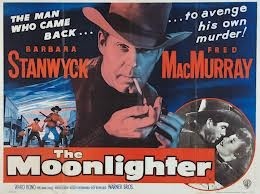
The Moonlighter
The beam of the moon – the scream of a woman – the savage meeting of The Moonlighter and his Midnight Lady!. This was how Stanwyck’s next film was tagged. She returned to the western with 1953’s The Moonlighter (Rowland) which was based on a screen story and screenplay written by Niven Busch, author of her previous western’s source novel. Playing opposite Fred MacMurray, her deadly co-star in Double Indemnity (Wilder, 1944) along with western veteran and Ford favourite, Ward Bond, it was the only time the star was shot in 3-D. It is one of her lesser roles in the genre nonetheless it bears examination as an example of how the text responds to the star’s particular attributes. Far from the formidable filmic organisation of The Furies, and lacking its narrative and visual rigour, the comparatively static film (probably at least partly due to the exigencies of the 3D format) is structured in two unusually distinctive halves with four sequences in each of approximately 10 minutes in duration. The first part recounts the story of Wes Anderson (MacMurray), the titular hero in the early part of the twentieth century, whose voiceover anchors the narrative: “It’s me they’re after: Wes Anderson.” He’s a rustler who plies his trade by moonlight, a creature of Western lore.
Sequences are a readily identifiable structural tool, as described by Wolitzer:
All scripts contain sequences – a series of thematically connected scenes that are powerful and memorable and direct the reader through the story… (Wolitzer, 1999: 91)
A screenplay’s structure is integrated fully with its controlling idea, or theme, which Linda Cowgill defines as follows: “Theme defines what a film experience is about; it determines the choice of incidents and events which make up the plot. At the end, when they are added up in the mind of the viewer, each scene and sequence should contribute to the ultimate discovery of what the film is about” (Cowgill, 1999: 151). Theme also “gives direction to the plot, defines the key issues for the characters and ultimately determines the depth of meaning for a work. It is the integrative force behind a great film and is essential for understanding what makes a film great” (Cowgill: 64). Similarly, Robert Riskin believed that theme was the most important element of the writer’s armoury. In his essay, ‘The Theme’s the Thing,’ first published in 1937-1938, he stressed the importance of this to his own screenplays and also dedicated several pages to the organisation and construction of his stories, which always adhered to the three-act structure (Scott, 2006: 125-6). [1] And in their guide to aspiring screenwriters, John Emerson and Anita Loos called theme ‘the chief trick of the trade’ (Emerson & Loos, 1921: 23). The theme of The Moonlighter can be encapsulated in the word freedom and it is in various interpretations of that term that the action is catalysed.
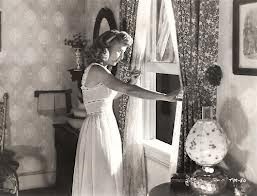
Changing perspectives
The eight scene-sequences in the film are as follows: Wes is captured by a lynch mob and installed in a jail cell where by previous agreement with the Sheriff he is supposedly captured and hanged, except that they take the wrong man, then drown his corpse and Wes swears revenge after busting out and then paying for ‘his funeral’; a lady called Rela (Stanwyck), who we eventually will learn is Wes’ former girlfriend, comes to town to stage the funeral and is regaled the story of it told in flashback by the funeral director, when a ‘W.O. Anderson’ gave a eulogy to ‘Wes.’ She returns home to Rio Hondo to tell his brother, Tom (William Ching) her new beau, it was clearly Wes and he is still alive; Wes then goes to the X-Bar Ranch “to even up the score” in the words of his voiceover and lassos the lynch mob’s ringleader, dragging him away before killing the Sheriff but he is himself shot in crossfire. He returns home to his mother and Tom where he discovers Tom’s relationship with Rela, who wants him to leave Tom alone or he will moonlight too; Wes’ buddy Cole (Ward Bond) arrives in town to plan a bank robbery where Tom works and Tom joins in because he’s been fired then gets killed during the escape – in a jalopy! Wes and Cole argue in their hideout where a deputised Rela, very much part of the law, eventually finds Wes tied up after she kills Cole; Rela tries to take Wes in but is nearly killed while they cross a waterfall and Wes saves her and agrees to go in, hand back the money and return to her after serving his jail sentence.
A film’s attractiveness to any star performer can often be measured by how many lines they have to say. The Moonlighter boasts one of the genre’s few monologues – a very lengthy eulogy which Wes offers as obsequy to himself. This is one of those occasions on which an actor has an uninterrupted platform in which to emote, orate, digress, abuse and praise – and Wes does this in excelsis. The monologue gives us backstory, premise, motivation and preparation for what will follow. It takes place as the funeral director’s flashback, told to Rela, who has come to town to organise Wes’ funeral only to discover that it has already taken place at the behest of one W.O. Anderson, alleged ‘relative’ of the deceased. “Even right now it seems to me like he still standing here talking to you like I am,” pronounces Wes, tongue firmly in cheek. He then proceeds to speak uninterrupted for the rest of the sequence giving us backstory, character and motivation. Ultimately, we have sympathy for Wes, a relatively harmless outlaw of sorts whose civility is then immediately undercut by his hold-up of the funeral attendees, who wind up paying for the burial.
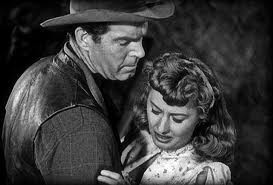
The decisions that are hard to bear
The second half of the film focuses on how Wes and Rela (Stanwyck) reconcile their differences after his five years away with their essential similarity expressed in the scene where they meet properly again – trying to kill the same rampaging mountain lion. Rela is now dressed in cowboy garb, having donned the appropriate ladylike dress and bonnet for her trip to the town to reclaim Wes’ body. Wes kills the predator first, which Rela says wouldn’t have happened in the old days. “You’ve changed, Wes,” she proclaims. “Nobody stays the same,” he responds. “You’ve changed too, Rela. Maybe you need people less.” “Maybe I need people more but I show it less,” she answers. This is clever dialogue in a film so dependent on the theme of freedom which seems rooted in adventures and decisions past. “I got wise to myself,” says Wes by way of explanation. “I know what people are like now.” Rela tries to make him see reason: “You can’t shut yourself off from people … you can’t make the whole world responsible for what a mob did to another man.” He states: “I’m probably the only man alive that saw himself hang. I know about people, Rela. I’m not sentimental any more. I’m strong because I can go my own way and that’s the road I’m going to travel.”
Stanwyck’s role here is one of the traditional western female, that of placating the hero as he embarks on a journey of self-awareness. Significantly here she is not identified as rancher’s daughter, teacher, wife, homesteader, dance hall girl or any other functionary in the canon. She is firmly individuated, primarily by dialogue. However the radical turn it takes is in her decision to become a Sheriff’s deputy and turn Wes in. She has made a decision for herself and that is to marry Tom: his death in the exchange of gunfire at the bank alters the course of her life and in turn alter’s Wes’ too. She is the voice of reason pleading for a belief in the cause of humanity – despite the actions of the mob. It is her decisive action – in killing Cole (perhaps an insider’s gloss on what should happen to a HUAC informer!) – and then her near-death on the waterfall that fundamentally dictates the course of the action. The paradox is that where Wes’ desire for revenge intersects with Rela’s desire for peace is their love – rekindled when he saves her life and agrees to be turned in. Their peaceable life together is postponed yet again, until he serves another jail term. “Nothing can stop us from now on.”
So while Stanwyck is ostensibly second billing in a dramatic sense and our reaction to the story is anchored by Wes’ voiceover, it is her pivotal decisions which turn the drama 180 degrees. Her performative choices are dictated by masquerade: she has turned to Wes’ brother whom she determines shall not follow the route of the moonlighter but who is unhappily festering at his 9 to 5 in the bank (which he eventually robs and is the death of him); she dresses as a lady yet is actually a fine shot and an excellent hunter (by her own admission Wes is now better than her after 5 years rustling); she feels compelled to enforce the law yet will welcome Wes back when he does his time. She is a complex individual with a strong sense of what is right – for everyone. It is a performance that demands our unwavering support for her decisions and she maintains that by a simply expressive tone, a firm delivery of the lines and a good physical command of the demanding shifts in behaviour. The theme of freedom is investigated with its obverse: the price that has to be paid for that freedom. Tom has paid with his life; another man has paid with his life for being mistaken for Wes; Wes has taken revenge for that act and now he must pay; Rela is now paying the price for Wes’ actions and her own decisions to do the right thing. If the action is static, the underlying narrative of cause and effect is rooted in significant moral choices.
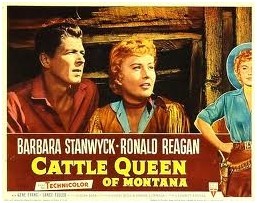
The Cattle Queen on Montana
Paired with Ronald Reagan in her next western outing, Stanwcyk was directed in colour by silent movie veteran Allan Dwan in Cattle Queen of Montana (1954). [2] Written by Robert Blees and Howard Estabrook and based on a story by Thomas W. Blackburn, the production is distinguished by the fine photography by one of the great noir stylists, John Alton and art direction by Van Nest Polglase. Stanwyck’s hair was tinted a reddish hue, the better to tone in with the beautifully lush verdant Montana scenery for which her father has named her – Sierra Nevada Jones. Her suitability to life on the land in this part of the world is written in her name. “She strips off her petticoats and straps on her guns!” ran the film’s tagline. The film opens on Stanwyck’s voiceover, introducing us to “Sunrise to sunset, driving our cattle all the way up from Texas …” She is a rancher’s daughter, arriving in Montana with her father to settle his claim with thousands of head of cattle in this wonderfully green landscape that plunges into deep chilly blue lakes and rises to a snow-peaked mountain range beyond. Reagan plays Farrell, an Army spy working as an enforcer for McCord, the avaricious rancher pushing all the settlers away with the help of a renegade band of Blackfeet who are trying to usurp the heir to the tribe, Colorados (Lance Fuller), an educated man whose efforts to translate peace back and forth between his tribe and the white settlers provides the foundation for the story’s structure.
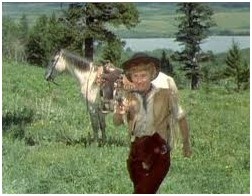
Establishing land rights the old-fashioned way
When Sierra and her father (Morris Ankrum) and their foreman Yost (Jack Elam) arrive to claim the land which her father has pre-empted ownership at the local bank they are quickly overwhelmed by a band of local Blackfeet put to the task by McCord (Gene Evans). Jones Sr dies in the raid and Sierra is taken in by another band of Blackfeet whom she presumes intend to kill her and Yost. Instead, Colorados has just returned from University and is keen to modernise and civilise and do away with the old order. Yost is brought to the medicine lodge. The girl whom he left behind, Starfire (Yvette Duguay) is immediately jealous of Sierra; although Sierra’s dealings with Colorados are exclusively to do with their mutual (mis)understanding and her efforts to reclaim her land and her cattle, which he aims to help her accomplish. She is also trying to help her foreman get better but when she reclaims her riverside plot she returns to their tepee to find that he has been shot in the back with an arrow belonging to men led by Colorados’ tribal enemy, Natchakoa (Anthony Caruso). Whereas Sierra seems to be able to trust her Blackfoot friend as he determines to root out the opposition, she butts heads with Farrell, who is working for McCord but is actually spying for the Army. When she prods Colorados for details about who might be working for McCord he explains, “First thing a white must learn is never ask one Indian about another.”
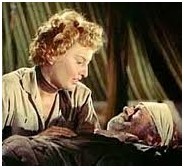
Tending her foreman
The narrative is thus structured around several polarities: the Joneses (now just Sierra) against the Blackfeet who attacked (under McCord’s orders); Sierra versus the Bank and McCord, who made a claim against Jones Sr’s pre-empt the day before he murdered him; Colorados versus Natchakoa; Natchakoa and McCord against the settlers; McCord and the Army against Natchakoa; Starfire versus Sierra; Sierra versus Farrell on occasions; Farrell versus McCord. This convoluted circular setup is clarified in action and dialogue scenes which showcase the stunning mountain scenery and is frequently foregrounded on steep hillsides leading to deep mountain lakes, with the Nevada mountains in the distance providing depth to the drama which frequently resorts to simple opposition and detail to convey duplicity in the various parties’ undertakings. Natchakoa is placated with whisky; Starfire laments Sierra’s seeming attractiveness to Colorados and her behaviour in aiding Natchakoa tips the action towards the story’s conclusion. Sierra’s conversations with Colorados emphasise the necessity for understanding between the races yet the dialogue scenes though redolent of meaning are directed statically. “Our people will live in peace,” he says, “they will not forget.” He has a project of modernisation to undertake with a great deal of opposition from within.
Some very well staged action scenes depict the stampedes that are caused at the film’s first attack on the Jones’ and later, when Colorados follows that run by Natchakoa, his nemesis. The film’s midpoint takes place at the river which literally parts the film in two: Sierra finds her father’s stone claiming ownership and the score changes to the sweetness of a mellow string arrangement to emphasise this coming together of father and daughter in a fashion that is diametrically opposed to the locking of horns in The Furies. The story effectively starts a second time when Sierra steadily regroups to activate his long-held dream which is now hers alone.
Stanwyck’s performance is on two registers: physically, she has to become the man of the family upon her father’s murder and go about the business both financially and tactically of taking on his enemies; she must also feminize her appearance and behaviour to appease both the Blackfoot squaws and the women in the town who strongly disapprove of her arrival on horseback with Colorados. She must achieve both in the same scenes at times and it is her sympathetic role that roots the forward movement of the action which is at times secondary to the stunning settings which are backdrops in magnificently shot dawn and twilight scenes. The romance between Sierra and Farrell is perfunctory at best but fits the dynamic of the genre, in which each character must change their behaviour and act like their real selves in order to achieve true individuation and justice to restore the status quo disrupted by the renegades in their respective communities. Sierra and Farrell exit through an enormous rock formation framing the shot, entering a valley of seemingly infinite green. “Now you can have everything you want,” he declares. “Including you?!” she asks. It is the closest the film can come to a happy ending with justice – and land – for all.
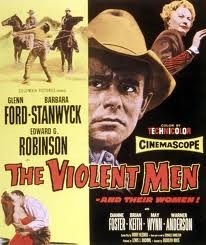
The Violent Men
The Violent Men (Maté, 1955) was adapted by Harry Kleiner from the novel SMOKY VALLEY by Donald Hamilton and is a pure evocation of sexual politics in the genre. It is the story of John Parrish (Glenn Ford) who is baited by local cattle baron, wheelchair-bound Lew Wilkison (Edward G. Robinson, a late replacement for Broderick Crawford) into giving up his pacifist ways in order retain the title to his land. Beautifully shot by W. Howard Greene and Burnett Guffey, it was here that Stanwyck physically materialised as the strong, matriarchal, blonde cattle queen whom she would come to personify as Victoria Barkley in The Big Valley. Powerful, tricksy, not entirely trustworthy, this was the iconic figure for which she would be remembered. The character in the TV series would borrow from some of the character tropes established here and in subsequent of Stanwyck’s western roles. The drama is triggered by the intransigence of Parrish, whose recollection and activating of military tactics structures the plot at key points. He may be principled but his ideology has been driven by pragmatism and he is not one to give up in a fight – he will always remain a soldier. It is those military decisions that give the narrative action its shape.
This format is a perfect example of screenplay structure, wherein the protagonist and antagonist alter the configuration of each other’s lives 180 degrees – here Stanwyck and Ford’s characters are protagonist and antagonist to each other. Stanwyck is married here to another of her Double Indemnity co-stars, Robinson, with whom she had also appeared in Flesh and Fantasy (Duvivier, 1943). Here they once again play husband and wife at Anchor, an enormous holding which has squeezed the ‘nesters’ out of their settlements in bitterly violent disputes, the last of which put Lew on crutches. His brother Cole (Brian Keith) is now cuckolding him but is also carrying on an affair with a Mexican woman in the town. Parrish wants to sell up to Anchor and go east with his sweetheart but the low price and the outrageous, murderous bullying forces him to revert to military tactics and he takes on the Wilkisons. Unbeknownst to him, he has an ally in their daughter Judith (Dianne Foster), who is disgusted by her mother and uncle and who ultimately allies herself with her father for the good of the land.
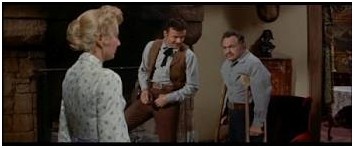
Martha and Cole think they have fooled Lew
As Cohan and Swires remind us, “story consists of events placed in a sequence to delineate a process of change, the transformation of one event into another” (Cohan and Swires, 1988: 53). Aristotle suggests that the connective tissue between incidents can be organised in such a way that the entire action of a drama can be united as a whole with individual sections of action which relate to the overweening arc of the drama itself:
Just as in other imitative arts the imitation is unified if it imitates a single object, – and one that is also a whole. So the structure of the various sections of the events must be such that the transposition or removal of any one section dislocates and changes the whole. If the presence or absence of something has no discernible effect, it is not part of the whole (1996: 15).
If we apply the rhetoric of screenplay structure to the entire cycle of seven westerns made by Stanwyck between 1950 and 1957, then The Violent Men signifies the midpoint sequence. A sequence approach in structural analysis is utilised by Paul Gulino, who reminds the reader that the structuring of screenplays into explicit sequences approximating 15 pages was standard practice until the 1950s. In fact early screenplay manuals advised writers to construct stories of screenplays into explicit sequences according to reel divisions. In this way the point of view could more easily be shifted to characters other than the protagonist in order to create more dramatic tension and sustain audience attention. He says “the difference between a sequence and a stand-alone fifteen-minute film is that the conflicts and issues raised in a sequence are only partially resolved within the sequence, and when they are resolved, the resolution often opens ups new issues, which in turn become the subject of subsequent sequences” (Gulino, 2004: 2-3). The midpoint sequence would be the focus of a film’s centralising issues, dramatised in a number of actions which express the narrative’s major conflicts. It sums up the film as a whole, its major characters’ desires and the principal action aligned with the story’s theme which is powerfully expressed through conflict.
If, then, The Violent Men, is the midpoint in this cycle of westerns, it expresses the fulcrum about which the narrative of the cycle as a whole pivots: the lengths to which women must go to assert their rights in a male-dominated society and the dangers that their desires expose. This was a powerful idea to express at this time in the culture. The distinguishing feature of the film’s narrative is its play of sexual politics, highlighted by the different registers of dialogue, with personal and tonal shifts expressing not just ‘business’ but inflected with character, all personalised to a degree unusual in the genre. As Andrew Horton rightly points out, “It may surprise you how much of most films breaks down to a series of dialogue scenes between two characters.” (Horton, 1999: 145). For Aristotle, diction (or dialogue) must form part of the dramatic action. He states, “Diction should be handled with particular care in those parts in which little is happening, and which are expressive neither of character nor of reasoning; excessively brilliant diction overshadows character and reasoning.” (Aristotle, 1996: 42). Michael Tierno reiterates, “Dialog is part of the action and gets its power from the plot, whose effect builds in a cumulative as well as linear way. Dialog forms story action and derives life and energy from the action it helps build.” Tierno continues: “…in even the most dialog-dependent script like My Dinner With Andre, the dialog is intrinsic to the action – to the plot, meaning, causality of the incidents and the dramatic unit” (Tierno, 2002: 129-130; 131). Dialogue is not, then, conversation; it affects the impact of conversation and carries character and action forward. It must differentiate characters from one another, imitate the rhythm of speech and at its best reveal subtext and deep character. In this instance it is purveyed not just on the level of distinctive individual voices pertaining to character roles and furthering (or slyly disguising) the purposes of the conversational exchange; it exists to express different registers and motivations, alternating and receding desires and intentions, and sexual difference. And of course, as with drama, as in life, people don’t always say what they mean and sometimes they even tell lies.
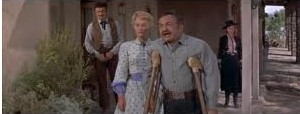
The power behind the throne
The structuring tool used is the deployment of dialogue to express Parrish’s strategic position in relation to the Wilkisons. At the film’s commencement, Parrish stands back while the Wilkison boys beat up one of their usual victims. When he meets Judith Wilkison she rags on him for trying to be different and when Martha brings him into the Anchor house her quiet attitude belies her position as the power behind her husband’s wheelchair-bound throne but Parrish admits that seeing the Sheriff shot in the back has spoiled his taste for hard liquor. Wilkison trades on the area’s history in his negotiation for Parrish’s land but what he offers is “not even a downpayment.” Martha canoodles with Cole and Parrish tells his foreman he will take the money and go. However the shooting of his man Bud turns the action at 38 minutes in and Parrish adopts a new tactic: pretend to retreat. When he then has a gun stuck in his back in the saloon he ends up killing Matlock, one of Wilkison’s men. At the film’s midpoint Parrish encounters Judith at Anchor again and tells Wilkison, “Don’t force me to fight, you won’t like my way of fighting.” Martha rubs her husband’s neck to the disgust of her daughter, who is repelled by her father’s being cuckolded. In the mountains that night Parrish directs his men, “Never meet the enemy on his own terms.” In the subsequent shootout his men line strategically amidst the rock and the brush of the mesa canyon and take on the Wilkison posse in a vivid scene. Eight men are dead and Wilkison learns that every rancher is on Parrish’s side. Judith leaves the Anchor because she believes her father misunderstands the situation, which has been stoked by her mother and her uncle. Martha ‘reasons’ with Lew: “I’ve reached the end of my endurance.” And, in front of the all-important map that lays out the land for his consumption, she goads, “I didn’t think you’d allow Parrish to stop you.” He admits to her: “I promised you the valley.” Judith explains the situation to Parrish; while Cole says to Martha, “You don’t need anybody, you never have, you never will.” He intends leaving for Dallas with his Mexican girlfriend, Elena.
The Anchor is burned out and Martha throws away Lew’s crutches and abandons him and the ranch in flames to have things out with Elena. Elena refuses to take a payoff. Lew covers for Martha when Judith comes back and finds him alive while Martha and Cole grandstand to the Sheriff about people building the country.” Anchor will be a fitting memorial to my husband,” she declares, unaware that he isn’t actually dead. Judith tries to make the men stop killing. A mob is gathered to avenge Lew’s death and at the gates of the ranch Martha is horrified to see Lew in situ and runs away, to be gunned down at the threshold by Elena, her rival in love. Back in town, where the story began, Judith approaches Parrish to the Anchor and work it with her father but he declines: “I’ve my own place to rebuild.” Then, both equal in shot size, he turns back and they ride out together. He has changed tactics once again: at the film’s beginning he states, “I want to get out of here and nothing’s going to stop me; now he tells Judith “You know your father once told me he’d get my ranch one way or another,” his fiancée long forgotten. While we learn that Martha had to be skewered by her own vanity, Parrish, we realise, is not a pacifist but a pragmatist.
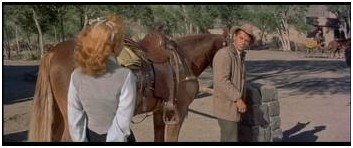
Parrish meets his match in Judith Wilkison
The significance of the role for Stanwyck is its combination of both sadistic and masochistic components: she wears the customary costume of rancher’s wife but is in reality the cuckolding mistress of a thug; she is a mother, not a role model; she is the reason for her husband’s avarice; she defines the terms on which everyone in her home lives, bar Cole, whose lechery cannot be controlled. It is important that she confronts him about his promiscuity in a stables (given the avowed symbolism of the horse in sexuality). Her silent pacing of the ranch lounge and her threatening smiles promise and deliver a world of pain in which her own husband has borne the brunt of injury, literally castrated on the ambitions of a land-hungry woman. Her actions change Parrish’s tactics and she cautions her husband that he is taking on a man who was a captain in the Army. She has met her match. Her early silences are parried with her later pithy comments; her contempt for Cole and his liking for cheap Mexicans are her own tactical way of keeping him on side long enough to sate her proprietorial desire; her lust for land is even more demeaning than her lust for her brother in law and it orients her to drive her husband on to more and more destruction until finally she is undone by jealousy. It is the sheer wantonness of her performance as an older woman scorned that so fascinates: her duplicity conceals from her that the blood on the landscape will eventually be her own. Even when the map of the valley is in flames and all appears lost she can see an opportunity for herself. It is the American dream. Stanwyck’s full-toothed grimacing smile was never used so effectively to achieve such evil affect.
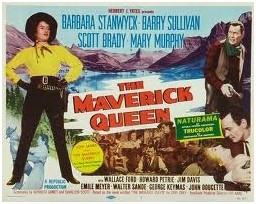
There was something about her
Since she was sixteen,
That attracted men to
The Maverick Queen.
The Maverick Queen
In The Maverick Queen (Joe Kane, 1956) working from an adaptation by Kenneth Gamet and DeVallon Scott of the Zane Grey novel, Stanwyck plays opposite Barry Sullivan (her co-star from Jeopardy, Sturges, 1953), a pairing that would pay dividends in a film shot in the Naturama format, presumably to take advantage of the wonderful location photography in this vague gloss on that exercise in perversity, Johnny Guitar (Ray, 1954) which had starred Joan Crawford and Mercedes McCambridge. Stanwyck is Kit Bannion, the proprietor of the eponymous hotel which bears her nickname. She runs with the Wild Bunch, and derives enormous satisfaction from giving the Sundance Kid (Scott Brady) the runaround, especially when a man claiming to be Jeff Young(er) (Sullivan) turns up to rival him in her affections.
A study in masquerade, the film’s entire narrative strategy is structured on characters being different to whom they claim to be. Kit was actually born to a wealthy Virginia family; Younger is actually a Pinkerton agent; Jamie (Wallace Ford) is a spy for Kit and not the loyal sidekick to rancher Lucy Lee (Mary Murphy) that she believes. It all ends in a hilltop shootout, with characters’ double identities and false loyalties steadily being revealed as one by one they are shot down.
Stanwyck’s role is as duplicitous as she could have desired: outfitted with copper hair, drop earrings and a Kelly green dress, she is introduced as a vivid picture of ambition. “I did what I had to do to get where I am.” She hopes she’ll meet a better man than Sundance, who, for his part, promises he will kill her. Lucy Lee, her polar opposite, is introduced as a more honourable farming woman with stock to sell, her family’s trusted helper Jamie by her side, and a masked stranger helping her when the Wild Bunch come calling. This contrast between the women is emphasised when she calls on Kit to buy her cattle – Kit is swathed in sheet black and elaborate feathers, ruling her particular roost, while Lucy is more straightforwardly attired by those standards. Young watches their interaction in a mirror. With Young(er) now established as a dealer in the hotel, it seems Kit literally holds all the cards. She watches him dealing in a green gown with a scarlet flower in her décolletage and introduces him to Sundance about raiding $50,000 in gold on an incoming train – it is a fateful event.
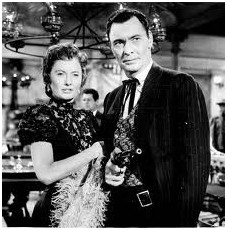
Shooting straight from the hip
The narrative essentially traces the progress of a good woman gone bad and Kit explains to Young(er) that “you don’t leave the Wild Bunch except feet first.” They discuss their mutual survival instincts. Stanwyck is given room to manoeuvre both in terms of costume, idiom and physique. She survived being burned out of her family’s plantation in Virginia and recalls branding all steers. She warns Young(er) of Sundance because of his fitful jealousies. She is offered an immediate contrast in Lucy, dressed cowgirl style, whom Young(er) accompanies to the train. This is when Jamie tells Kit that Young(er) was present at the rustling of the Lee cattle. She receives this news enveloped in a white dressing gown with a peach neck, high to the jawline, her hair in a pony tail: the effect is of an immediate softening, a development from the tough broad we have already encountered. Thus we have both a difference from her earlier presentation and a difference to mark her out from Lucy, an equally determined woman but in a rather more conventional, non-threatening vein. After the raid Kit is greeted by Sundance and Young(er) at the safe house in the hills, clad in white shirt and a black hat with a red bandana and trousers. She tends to her own horse, with Sundance watching, clearly incensed. She is protecting Young(er) and the identity that she still presumes him to have. Inside, she talks to him about her vision for the future: “This country is changing. Settlers are coming and in a couple of years the gang will be wiped out. It’s too late for me. I’ve been remembering what it was like. Happiness, peace of mind, contentment.”
At heart, this may be a story of outlaws but it centres on the idea of progress and the locus of sexual politics and the meaning that these might have for the future. The safety net is in the past: a form of nation-building based on violence; the costume of disguise; the taking of land, cattle and lives for personal gain. The narrative is predicated on the shifting identities presented in masquerade, male and female, and when Jamie is unmasked as being responsible for the death of Lucy’s father it seems to unleash a force of moral retribution. Young(er) is revealed as a Pinkerton detective, he fights it out with Sundance in a dramatically deforested area in front of a sheer mountain backdrop and Sundance eventually dies after his own knife ends up in his back. The Maverick Queen has been rumbled and eventually after several double-crosses between the Bunch, she dies in the arms of the man who made her see the error of her ways. We learn that the Wild Bunch has ended its reign because of her. Politics and gender are conjoined in this flagrant bid for sympathy which flies in the face of her sexuality, goading these foolish men to their deaths in their efforts to aggregate her personal wealth. If Kit is the leader, Lucy is probably a more positive role model for future gender mobility, with the final message to the audience being, crime does not pay.
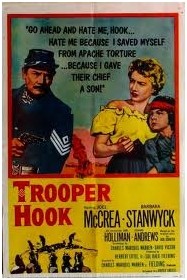
Trooper Hook
Trooper Hook (1957) was the penultimate western film Stanwyck made and was released on 12 July 1957. Based on a story by Jack Schaefer (famed for his novel Shane which George Stevens shot in 1951 and was released in 1953) it was written by David Victor, Martin Berkeley and Herbert Little Jr., with contributions by director Charles Marquis Warren. Re-teamed with her old sparring partner, Joel McCrea, in this their sixth and final pairing together [3], the plot recounts what happens following the massacre of a regiment by Indians. Trooper Hook (McCrea) captures the Indians and starts talking to their leader, Nanches (Rodolfo Acosta). Hook discovers that the leader’s squaw is a white woman, Cora (Stanwyck), taken captive nine years earlier and she has borne him a son, Quito (Terry Lawrence). His task is to return the woman to her husband. She leaves with her son by stagecoach but Nanchez eventually catches up with them after escaping imprisonment, intent on reclaiming the boy. The journey effectively reveals Cora to Hook and vice versa as they engage first with their fellow passengers and then he displays his ruthless side when in an attack by Nanchez he threatens to have the boy killed rather than return him to the tribe.
Cora has to contend not only with the approbation of the women around her when she is rescued, but with the prospect of rejection from the husband she was going to meet when her wagon train was attacked on the trip from back east. She is accustomed to the dirty looks that she got from the squaws in the Indian camp but now she is confronted by the disgust of her fellow white women. Cora is exposed to the civilised world slowly, first by kindness from a Major’s wife; by self-recognition, literally, when she looks at her reflection in a mirror for the first time since being taken captive and speaks her name softly to herself; and when she speaks in public and threatens to kill the white men who berate her for having had a son by an Indian. “Take your hands off my son! Animals, all of you, animals! If you so much as touch my son I’ll kill you!” she roars, a lioness protecting her cub. These are her first words in her native language in eight years. “Mighty powerful sentiments, but they sounded real good,” marvels Hook drolly. Stanwyck is marvellous in her first silent scenes, relying on her face and simple, affective gesture to express deep pain at the cataclysmic turn her life has taken. She also registers annoyance, confusion and grief. She can’t yet speak but her contained emotions convey thanks when she is shown generosity. She holds on tightly to Quito, for fear she should ever lose him. She looks down at the ground and the floor, fearful of eye contact, of giving herself away. It is a finely judged performance of perfect stillness that hints at depths of confused feelings. When she finally speaks it is a volcanic eruption. When she truly expresses herself, it is a relief as much for the audience as it must be for her character.
Hook’s protective attitude towards the child and his sense of injustice when Cora is refused entry to a dining room shows his humanity but also his pragmatism. He understands when she explains her survival instinct as a captive: “Just now in that water watching my son, listening to him laugh, that one moment was worth all those years. Can you understand wanting so much to live?” Hook’s silence tells us that he does. If he meets Nanchez on equal footing, to some extent, he also differentiates himself from him. “I am familiar with your mind,” says the Indian. “You will not let the blood of my son make you soft.” Hook responds, “You leave me no choice.” They understand each other too. The final unhappy reunion with Cora’s husband, alone all these years after she was captured en route to starting their new life together, pinpoints all the characters’ beliefs and establishes just how far each of them is prepared to compromise. The husband’s lack of preparation for such a moment means he is killed by Nanchez; but also means he has the opportunity to kill Nanchez, an act of equalising that sets in motion the relationship that we know is destined to be prolonged. It is in the order of things in this fascinating variation on the captive tale with its inbuilt fears of race, miscegenation and sexuality.
Egri formulated the classic approach to dramatic writing in which he states premise – or theme – as the central component of the successfully written play
Every good play must have a well-formulated premise. There may be more than one way to phrase the premise, but, however it is phrased, the thought must be the same.
He urges the playwright:
You must have a premise – a premise which will lead you unmistakably to the goal your play hopes to reach. (Egri,: 6)
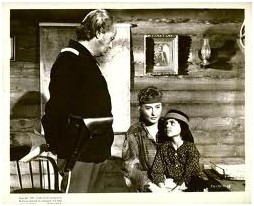
Cora’s silent return to the white world
He also states: “In a well-constructed play or story, it is impossible to denote just where premise ends and story or character begins” (Egri: 29). And: “Neither the premise nor any other part of a play has a separate life of its own. All must blend into an harmonious whole” (Egri: 31). The theme of the white woman taken as squaw had already been attempted on a number of occasions but Stanwyck’s pivotal star role was a major development in the story’s telling and the fact that she plays the mother to an Indian leader’s child creates a tension hitherto unknown in this subset of the genre. The premise is perfectly expressed in her performance, getting to the root of Cora’s emotional intelligence, with her intensity bouncing off McCrea’s more relaxed take on Clovis Hook. She gauges the quality of her subjectivity from the protectiveness that any mother would have towards a child being threatened with removal from her care. The shooting of her husband by Nanchez clarifies what she already knows about Hook and the life they will have together; his own family life being a fabrication to avoid difficult conversations at the cavalry posting making this a rather extraordinary and modern marriage of convenience.
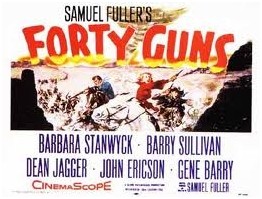
40 Guns
It is fitting that the seven-film cycle of westerns that Stanwyck made in the 1950s was bookended with the other great western role of her career. In Forty Guns (1957) cult writer and director Samuel Fuller had Stanwyck introduced with yet another one of the requisite theme songs that was attached to the decade’s westerns: “She’s a high-ridin’ woman with a whip!” In fact, the film was originally titled Woman With a Whip, but Warners objected because of its deviant connotations so Fuller was forced to change it (but the song remained the same). The role was one that Marilyn Monroe campaigned for (she had co-starred with Stanwyck in Clash By Night, Lang, 1952), but Fuller stood his ground, and got his woman, and, once again, Stanwyck was the cattle queen of all she surveyed in a rousing production which boasted Fuller’s typically arresting visuals, stylish storytelling and vividly subversive suggestiveness in a florid, phallic melodrama. Jessica Drummond (Stanwyck) is the precise, strongly delineated and robust persona that would lead Stanwyck to shortly becoming the leading lady of TV westerns with her long-running series, The Big Valley (1965-1969). For now she was playing once again opposite Barry Sullivan as the marshall and with Fuller as her director she could react to the muscular direction with a phenomenal performance in one of those films from a man whose occasionally lurid, permanently flamboyant work is still fairly uncategorizable in terms of American cinema. He defined film for Godard as “a battleground – love – hate – action – violence – death – in a word – emotion!” in Pierrot le fou (1965) and his taut signature is still staggering. A combination of brutality, abstraction and remarkable directness, he was a perfect complement to Stanwyck in this, one of her most perfect films.
Tone has been described as “the visual and verbal detail that directs us toward meaning” (Dancyger, 2001: 75). Al Alvarez states “… it is the business of writers to create as true a voice as they can” (Alvarez: 121). In Aristotle’s formulation,
…the action is performed by certain agents. These must be people of a certain kind with respect to their character and reasoning. (It is on the basis of people’s character and reasoning that we say that their actions are of a certain kind, and in respect of their actions that people enjoy success or failure.) (Aristotle, 1996: 11)
Aristotle is declaring that the ‘agents’ of the drama set the tone and influence the audience. Tone is perhaps the ineffable marker of any filmmaker’s work, expressing their point of view and therefore constitutes the totality of their ‘voice’ – or pitch. Tone can be described as a general or prevailing character, traceable across an oeuvre. With Samuel Fuller, the tone of any of his work is encoded with subtext of a peculiarly sadistic kind. He also demonstrates an authentic writing voice, which Alvarez likens to “perfect pitch… a natural gift, innate and distinctive, by which the best poets give new life to exhausted conventions and mold them to suit themselves (Alvarez: 49). Fuller’s reputation as auteur is one in which tone shifts to express an underlying violence based on sexuality and animal instincts. His visuals are pure and direct, thrusting and Freudian. Griff is tracked through the town confronting the bullies twice – at the film’s commencement and at the end when he kills Brockie. The camera has the viewer by the throat with its tight focus on this unstoppable force of righteousness, like the Bible’s pale rider. Wes Bonnell (Gene Barry) is the actively phallic brother, looking at the town’s unusually attractive female gunsmith Rio (Ziva Rodann) down the barrel of a rifle in a shot of rare bravado, before cutting away to the couple in a highly suggestive embrace. Then he gets shot in the back by Brockie just as he is about to kiss his new bride. In this drama of gunslinging, retribution, understanding and forgiveness, Jessica is clearly the power behind the men but she has to be turned and part of her change stems from those elements of the past she has to reconcile with the present predicament partly due to the failed dynamics in her own family structure: her brother simply must die. An eye for an eye. But when Griff’s youngest brother, Chico (Robert Dix) saves Griff from certain death, Griff is disappointed and when Chico asks him why, he states bluntly, “you killed a man.” It is a confession made in sorrow. Another aspect to Jessica’s concession is her admission, “the frontier is finished.” And this is her particular sorrow.
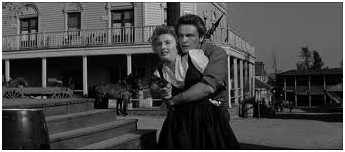
Wrestling with reason
Fuller once stated that, “To work with Stanwyck is to work with the happy pertinence of professionalism and emotion. She’s superb as a queen, slut, matriarch, con girl or on a horse… her form or class or appeal or whatever you want to call it stems from tremendous sensitivity and thousands of closeted thoughts she can select at will, at the right moment, for the exact impact.” Fuller has the full panoply of cinematic tools at his command yet it is the planes of Stanwyck’s face which concentrate the director’s focus. Long rumoured to be gay, with a supposedly convenient lavender marriage to Robert Taylor, Stanwyck’s role in Forty Guns is perhaps the queerest in the western cycle and lends itself easily to a reading in terms of transgressive representation. Dressed in black, riding a white stallion, brandishing her guns actual and living, she runs Tombstone as her own personal fiefdom. When they first meet she declares, “I’m not interested in you Mr Bonnell,” and fondles her six-shooter. The sequence in which she introduces Griff to the ranch’s hiding places is the transitional focus of the narrative: escaping with Griff from the swirling storm of sand and tumbleweed that represents the emotions churning in Jessica, snuggled up together in the shack her father first built before he acquired his wealth she relates how her mother died giving birth to Brockie (John Ericson); how she was almost killed by a rattlesnake and shot it; how she learned the ropes at her father’s elbow. “I was born upset,” she admits. It is here that Griff embraces her and they commence their love-hate relationship; it is here that Griff later finds her concealing Brockie beneath a rough mattress. She protests that murder is not in her brother’s blood; Griff says, “With your brand on him anything could be in his blood.” This ‘safe place’ is where Jessica’s better qualities are revealed; yet it is Fuller’s medium close ups of Stanwyck’s remarkable face, heading her Forty Guns at the dining table, that make the most impact. She is literally ravished by the camera in this her most sensual performance. It’s as though Sugarpuss O’Shea were transplanted to Tombstone, older and a lot wiser. This, it seems, is the Jessica we need, a powerful woman, man and woman, to a whole host of men whose livelihoods are at her whim, a fact made clear when she pays off the Sheriff (Dean Jagger) after his failure to kill Griff. He is devastated; however the drama is calibrated so cleverly and Stanwyck embodies her ferocity so sympathetically that we empathise with her. His feelings are for nothing. When Griff finally kills the untameable Brockie, Jessica, now dressed in conventional women’s attire of blouse and skirt, runs after him and, at the end of the long street, it seems he pauses long enough for her to jump on his carriage as he leaves town. The good man has won her over after he has killed her own brother, something she realises is necessary for the good of the community. She has been contained and recuperated by the love of a good man: the end, it seems, justifies the means. And, as the song reminds us, “you may find that a woman with a whip is only a woman after all.”
Conclusion
The western conjoined the underpinning politics of the United States: the right to individualism; the right to bear arms; and the right to farm the land under the expansionist schemes of the late nineteenth century. The genre was a safe place in which to express seemingly contradictory desires and those of the active woman, declaring ownership and intent in the guise of civilising the barren lands. In Corber’s framework we can read into Stanwyck’s representation the seat of a filmic conflict: the appropriation of the masculine for the purposes of achieving a significant feminine role in a generic style usually thought to be dominated by male characters in which the female was the sweetly submissive adjunct. However Stanwyck’s own dualistic possibilities, her attractiveness to both men and women, and her own powerful range of emotions, denying the definition of the actress as un-feminine or even as a Hollywoodized (ie acceptable) Lesbian renders her actuating presence in a western role as a powerfully ambiguous complex individualism which is too difficult to pin down, either as normative or alienating. Her expressive dialectic spans the whole spectrum of communication and performativity. She dons traditional female clothing when it is necessary to admit to her typically feminine wiles; she wears appropriate trousers and hats when she is horseriding on the range. She shoots when it is required. She is, above all, adaptive and multi-layered. And yet she admits (ultimately) in all her roles that she will be happiest when she has the man she wants. It appears to be as much about control as love. This is why her role in the western genre is so significant to the representation of women to the era, replete with contradictions, wildly expressed emotions and.desiring of power, above all. “I need a strong man to carry out my orders,” she explains as Jessica Drummond. And she has many of them, worshipping at her feet.
A genre which evolves to now permit its protagonist to be a strong female, wielding not just whips but sixguns, wearing buckskins and cowboy hats, owning half the range, opens up the rhetorical parameters to greater scrutiny and dates Bazin’s claims. The overdetermined ideology of the western itself, based on the binary structure which ultimately devolves upon the strong male and the supportive female, is cracked wide open in Stanwyck’s casting as the lead in all of her 1950s work. If melodrama is the underlying affective mode of cinema and its genericity, then it also permits within its structure for conflict and contradiction. These parameters are extended still further in the casting of such a powerful, androgynous performer, creating distance from the traditional image and thereby effecting another layer of complication in reading through the masquerade to produce an identifiable affect.
Barbara Stanwyck’s affiliation to the western genre is a good example of how the studio system could accommodate a strong actress with an allure of strength to both male and female viewers. Her particular affinity with this mode of address can be summarised in those aspects of performative femininity that she mastered in order to be appealing to both men and women in terms of gender fluctuation – adopting the codes of behaviour, dress, masquerade, sleight of hand and an adaptive approach that saw her master big and small screen in a genre which was adaptive to the changing social and sexual mores at a crucial time in the culture. Stanwyck’s position as queen of the Hollywood screen was no doubt in danger throughout the 1950s, a decade which saw off many of her former rivals yet which saw her thrive in this genre which she made her own and which complemented her performances in other major screen modes of the time in which she was equally active. Her subversive qualities and regal film titles (‘Cattle Queen’ etc.) ensured that her audience expected and got a series of magisterial performances of renegade women forced to take action to reclaim their power, land and status. This chimed with the emerging message of the time, when women were chained to their domestic appliances, perverted ‘Momist’ politics prevailed and the powerful women’s films of the previous decade suddenly seemed to have been wish fulfilment of the most extreme kind. Stanwyck appeared in a number of TV western episodes – Zane Grey, Wagon Train and Rawhide – before her campaign for her own series finally bore fruit. Her resonating screen power at the birth of the women’s movement cannot be underestimated: her weekly appearances as a powerful landowning matriarch on TV screens every week throughout the late 1960s as Victoria Barkley in The Big Valley were a reminder of what women could gain if they maintained their core strengths (and inherited a big ranch, perhaps). It is perhaps a disappointment to learn that the woman born Ruby Stevens was one of the founder members of the Motion Picture Alliance for the Preservation of American Ideals, an extreme right wing organisation that fed into the HUAC Red Scare; and that her position included extolling the work of Ayn Rand, from whom even the most dedicated Reds needed to distance themselves following her lunatic testimony on their behalf. However, personal politics aside, Stanwyck’s radical renegade roleplaying; her emotional range; her subtle gestural power; her emotional warmth and sheer screen charisma, belie a cunning career management strategy that saw her become one of the most respected actresses of any era and had many directors declare of her that she was the greatest with whom they had had the pleasure to collaborate. Towards the end of her life, she said, “I’m a tough old broad from Brooklyn. I intend to go on acting until I’m ninety and they won’t need to paste my face with makeup.” Being a frontier heroine for the ages, she very nearly did.
Endnotes
1 Scott comments, “The article placed great emphasis on a writer’s knowing his or her theme and how that theme can and should work, whether the genre is comedy, melodrama, or message film.” Ibid.
2 This was the film playing at the neighbourhood movie theatre in Back to the Future (Zemeckis, 1983).
3 The other films that Stanwyck and McCrea made together were: Gambling Lady (Mayo, 1934); Banjo on My Knee (Cromwell, 1936); Internes Can’t Take Money (Santell, 1937); Union Pacific (DeMille, 1939); and The Great Man’s Lady (Wellman, 1942).
Bibliography
Books
Alvarez, Al (2005). THE WRITER’S VOICE. London: Bloomsbury.
Andrew, Geoff (1989). THE FILM HANDBOOK. Essex: Longman.
Aristotle (1920). ON THE ART OF POETRY. Translated and with an introduction by Ingram Bywater. Oxford: Oxford University Press.
________ (1996). POETICS. Translated with an introduction and notes by Malcolm Heath. London: Penguin.
Basinger, Jeanine (1993). A WOMAN’S VIEW: How Hollywood Spoke to Women 1930-1960. London: Chatto & Windus.
________ (2007/1979). ANTHONY MANN. Middletown, Ct: Wesleyan University Press.
________ (2007). THE STAR MACHINE. New York: Vintage Books.
Bazin, André (1992). WHAT IS CINEMA? Vol. I. Berkeley: University of California Press.
Cohan, Steve and Linda M. Shires (1988). TELLING STORIES: A Theoretical Analysis of Narrative Fiction. New York & London: Routledge.
Corber, Robert J. (2011). COLD WAR FEMME: Lesbianism, National Identity, and Hollywood Cinema. North Carolina: Duke University Press.
Cowgill, Linda (1999). THE SECRETS OF SCREENPLAY STRUCTURE. California: Lone Eagle Press.
Dancyger, Ken (2001). GLOBAL SCRIPTWRITING. Boston, Mass: Focal Press.
DiOrio, Al (1984). BARBARA STANWYCK: A Biography. New York: Coward McCann.
Doane, Mary Ann (1987). THE DESIRE TO DESIRE: The Woman’s Film of the 1940s. London: MacMillan Press.
Dyer, Richard (1998). STARS. London: British Film Institute.
Egri, Lajos (1946). THE ART OF DRAMATIC WRITING: Its Basis in the Creative Interpretation of Human Motives. New York: Touchstone Books. Reprinted 1960.
Emerson, John & Anita Loos (1923). HOW TO WRITE PHOTOPLAYS. Philadelphia: 1920; reprinted George W. Jacobs & Co.
Gledhill, Christine (ed.) (2008). GENDER AND GENRE IN POSTWAR CINEMAS. Illinois: University of Illinois Press.
Gulino, Paul Joseph (2004). SCREENWRITING: The Sequence Approach. New York: Continuum.
Horton, Andrew (1999). WRITING THE CHARACTER-CENTRED SCREENPLAY. Berkeley and Los Angeles: University of California Press.
Howard, David & Edward Mabley (1993). THE TOOLS OF SCREENWRITING: A Writer’s Guide to the Craft and the Elements of a Screenplay. New York: St Martin’s Press.
Hunter, Lew (1993). LEW HUNTER’S SCREENWRITING 434. New York: Perigee Books.
Kaminsky, Stuart M. (1977). AMERICAN FILM GENRES: Approaches to a Critical Theory of Popular Film. New York: Dell Publishing Co.
Kitses, Jim (1969). HORIZONS WEST: Anthony Mann, Budd Boetticher, Sam Peckinpah: studies of authorship within the Western. London: BFI/Secker & Warburg.
________ and Gregg Rickman (eds.) (1998). THE WESTERN READER. New York: Limelight Editions.
Lackmann, Ron (1997). WOMEN OF THE WESTERN FRONTIER IN FACT, FICTION AND FILM. Jefferson, North Carolina: McFarland & Co., Inc.
Madsen, Axel (1994). STANWYCK. New York: Harper Collins.
McGilligan, Patrick (1975). CAGNEY: The Actor as Auteur New York: A.S. Barnes & Co.
McLellan, Diana (2000). THE GIRLS: Sappho Goes to Hollywood. New York: St Martin’s Griffin.
Mehring, Margaret (1990). THE SCREENPLAY: A Blend of Film Form and Content. New York: Focal Press.
Murdock, Maureen (1990). THE HEROINE’S JOURNEY: Woman’s Quest for Wholeness. Boston & London: Shambhala.
Palmer, Linda (1998). HOW TO WRITE IT, HOW TO SELL IT: Everything a Screenwriter Needs to Know About Hollywood. New York: St Martin’s Griffin.
Pearson, Carole (1986). THE HERO WITHIN: Six Archetypes We Live B. San Francisco: Harper & Row.
________ and Pope, Katherine (1976). WHO AM I THIS TIME? Female Portraits in American and British Literature..New York: McGraw-Hill Co.
Rogers St Johns, Adela (1956). HOW TO WRITE A STORY AND SELL IT. Garden City, New York: Doubleday & Co.
Scott, Ian (2006). IN CAPRA’S SHADOW: The Life and Career of Screenwriter Robert Riskin. Lexington: University of Kentucky Press.
Thomson, David (1994). A BIOGRAPHICAL DICTIONARY OF FILM. London: Andre Deutsch.
Tierno, Michael (2002). ARISTOTLE’S POETICS FOR SCREENWRITERS. New York: Hyperion Books.
Tuska, Jon (ed.) (1976). CLOSE UP: The Contract Director. Metuchen, NJ: Scarecrow Press.
Wolitzer, Meg (1999). FITZGERALD DID IT: The Writer’s Guide to Mastering the Screenplay. New York: Penguin Books.
Wright, Will (1975). SIX GUNS AND SOCIETY: A Structural Study of the Western. Berkeley: University of California Press.
Journal Articles
Callahan, Dan (2005). ‘Golden Boy: The Sexy Ways of Joel McCrea,’ Bright Lights Film Journal, 50, November 2005.
Handzo, Stephen (2012). ‘Going Through The Devil’s Doorway: The Early Westerns of Anthony Mann,’ Bright Lights Film Journal, 76, May 2012.
Harvey, Stephen (1984). ‘The Strange Fate of Barbara Stanwyck,’ Film Comment, March/April 1981: 34-36.
King, Torey L. (1997). ‘Barbara Stanwyck: Warrior Woman in Hollywood’s Gender Wars.’
Mulvey, Laura (1981). ‘Afterthoughts on “Visual pleasure and narrative cinema” inspired by Duel in the Sun,’ Framework no. 15/16/17, Summer 1981.
Rieupeyrout, Jean-Louis (1952). ‘The western: a historical genre,’ Quarterly of Film Radio and Television, vol. 3, Winter 1952.
Vanneman, Alan (2007). ‘Ronald Reagan’s Shoot From Hell!: Cattle Queen of Montana,’ in Bright Lights Film Journal, 57, August 2007. Accessed 20 Feb 2013.
Filmography
Annie Oakley (1935) d. George Stevens (RKO Radio Pictures)
California (1947) d. John Farrow (Paramount Pictures)
Cattle Queen of Montana (1954) d. Allan Dwan (Benedict Bogeaus Productions, RKO Radio Pictures)
Forty Guns (1957) d. Samuel Fuller (Twentieth Century Fox Film Corporation)
The Furies (1950) d. Anthony Mann. (Hal Wallis Productions/Paramount Pictures)
The Great Man’s Lady (1942) d. William Wellman (Paramount Pictures)
Maverick Queen, The (1956) d. Joseph Kane (Republic Pictures)
Moonlighter, The (1953) d.Roy Rowland (Joseph Bernhard Productions/Warner Bros.)
Trooper Hook (1957) d. Charles Marquis Warren (Filmaster Productions, Sol Baer Fielding, United Artists)
Union Pacific (1939) d. Cecil B. DeMille (Paramount Pictures)
Violent Men, The (1955) d.Rudolph Maté (Columbia Pictures Corporation)
Copyright
All images courtesy Columbia Pictures Corporation, Paramount Pictures, Republic Pictures, RKO Radio Pictures, Twentieth Century Fox Film Corporation, United Artists, Warner Bros.
Also of interest: Read Doug Buck’s essay on Samuel Fuller’s Forty Guns

